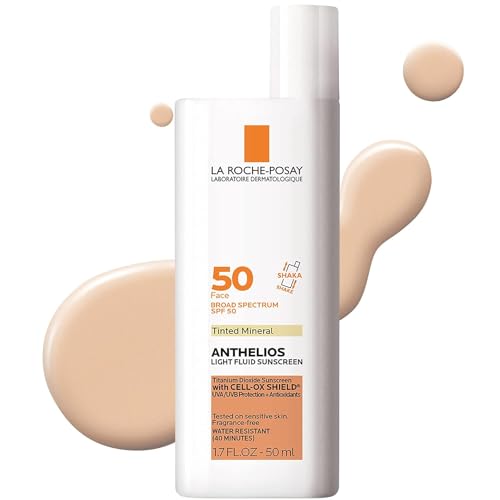Did you know that just 15 minutes basking in the sun can start to harm your skin? That’s right, and it’s precisely why sun safety should be at the top of your health checklist. With the growing discussion around the dangers of photoaging – that’s skin aging due to sun exposure – and the many myths surrounding the idea of getting a “healthy tan,” it’s high time we cleared the air.
Let’s review how sunscreen and other protective strategies can ward off harmful rays, and ultimately, we’ll tackle the burning question: Can we relish the sun’s warmth without compromising our skin’s wellbeing? It’s all about striking that perfect balance between enjoying those sunny days and keeping our skin shielded from potential harm.
More from Glowing Gorgeous: Find out here the Best Silicone-Free Moisturizers And Why Do You Care
Glowing First Glimpse
- Yes, you can enjoy the sun without any harm by following effective sun protection strategies.
- Choosing the right sunscreen, such as La Roche-Posay Anthelios , wearing protective clothing, and limiting direct sun exposure are key to preventing sun damage.
- Treating existing sun damage involves a combination of professional dermatological treatments and at-home care.
UV Radiation and Its Effects
The sun emits a range of electromagnetic radiation, but it’s the ultraviolet (UV) rays that we really need to watch out for when it comes to our skin. There are two main types of UV rays that affect the skin differently: UVA and UVB. UVA rays are the ones responsible for aging the skin. They penetrate deeply, causing long-term damage like wrinkles and age spots. UVB rays, on the other hand, are the culprits behind sunburn. They damage the skin’s outer layers, playing a significant role in the development of skin cancer.
When we talk about photoaging, we’re referring to how sun exposure accelerates the aging of the skin. Those fine lines, wrinkles, and changes in texture? Much of that can be chalked up to UV exposure over the years. This is because UV radiation breaks down collagen and impedes new collagen production, a double whammy for skin aging.
This brings us to the importance of broad-spectrum protection. A broad-spectrum sunscreen protects against both UVA and UVB rays, offering a shield against sunburn, skin cancer, and premature aging. Considering the American Cancer Society’s data showing a significant rise in skin cancer rates, and the Cancer Council’s research on how sun damage accumulates over time, it’s clear that a broad-spectrum approach is crucial for long-term skin health.
Statistics reveal a worrying trend: a vast majority of skin aging signs are a result of sun exposure. It’s a wake-up call for many of us who love the sun but may not have been diligent about protection. Understanding the science behind UV damage is the first step to changing our habits and protecting our skin’s future.
Choosing the right sunscreen is like finding a good friend – it’s all about protection and reliability. SPF, or Sun Protection Factor, is a measure of how well a sunscreen will protect skin from UVB rays, the kind of radiation that causes sunburn and contributes to skin cancer. However, and here’s the kicker, a higher SPF doesn’t always mean superior protection. It’s a bit like assuming the biggest umbrella is always the best choice for a rainstorm; sometimes, it’s more about the quality and suitability for the situation.
Broad-spectrum sunscreens are the friend you want to bring along to every outdoor party. These products protect against both UVA and UVB rays – think of UVA rays as the ones that age us (A for aging) and UVB as the ones that burn us (B for burning). The “Sunscreens: Protect Your Skin – Health Encyclopedia” explains that for a sunscreen to truly shield your skin, it needs to fend off both types of rays.
When picking a sunscreen, consider its water resistance, especially if you’re planning a beach day or a sweat-inducing hike. Broad-spectrum protection and an SPF rating between 30 and 50 are your golden tickets to a sun-safe outing. Water resistance helps the sunscreen stay effective longer, even if you’re taking a dip or getting your sweat on.
Now, let’s talk application – because slapping it on haphazardly won’t do the trick. Apply a generous layer to all exposed skin, and do it 15 minutes before you head outside so it has time to absorb. Reapply every two hours, or more often if you’re swimming or sweating like you’re running a marathon in a sauna.
And, oh, the myths about sunscreen and sun protection are as rampant as the rumors in high school. Some think sunscreen can completely block all UV radiation or that a tanning bed session before vacation can prep your skin. Let’s set the record straight: no sunscreen blocks 100% of UV rays, and tanning beds are more frenemy than friend, significantly raising the risk of melanoma skin cancer. It’s better to build your protection strategy on solid, scientifically backed facts than on wishful thinking.
One standout product is the La Roche-Posay Anthelios Melt-in Sunscreen Milk SPF 60.
This sunscreen not only offers broad spectrum protection against both UVA and UVB rays but also has a fast-absorbing, velvety texture that doesn’t leave a white cast or greasy feeling. Its formulation is suitable for sensitive skin, offering high protection while being comfortable for daily use. It’s a great addition to your skincare routine to ensure enhanced UV protection.
More from Glowing Gorgeous: Find out here Hyram’s Recommended Face Sunscreens For The Summer
In summary, the right sunscreen acts as a powerful ally against the sun’s harmful effects, offering broad-spectrum protection against both UVA and UVB rays. Considering factors like SPF rating, water resistance, and the type of protection offered helps in choosing the most effective sunscreen. Proper application is crucial for maximum protection, and debunking common myths about sun protection ensures more informed decisions. Always remember, when it comes to sunscreen, more is more.
Protective Clothing and Accessories
Dressing for Sun Safety
When we talk about combating the harsh effects of UV rays, we often leap straight to sunscreen. But, let’s not forget the power of a good outfit. It’s crucial to choose clothing that offers UV protection. Dark colors and dense fabrics are your best friends as they absorb UV rays more effectively than lighter shades. Also, opting for materials designed for sun protection, like those with Ultraviolet Protection Factor (UPF) ratings, can significantly reduce the risk of sun damage.
Head to Toe Protection
Don’t overlook the importance of a hat and a chic pair of sunglasses when stepping out. A wide-brimmed hat can shield your face, neck, and ears, places where skin damage often shows up first. And when it comes to your eyes, UV-blocking sunglasses are non-negotiable. They protect against cataracts and other eye conditions related to sun exposure. Look for sunglasses that block out 99-100% of both UVA and UVB rays to ensure your eyes are fully protected.
Special Considerations for Children
Kids love the sun, and the sun loves them a bit too much at times. Protecting children from UV exposure requires more than just slathering on sunscreen. Dress them in loose, lightweight clothing that covers most of the skin, and don’t forget a cute, wide-brimmed hat and UV-blocking sunglasses. Remember, their skin is more sensitive, so opting for UPF-rated clothing can significantly reduce their risk of sun damage.
Limiting Sun Exposure
One of the simplest yet most effective ways to prevent sun damage is by limiting exposure to the sun, especially during peak hours when UV radiation is at its fiercest. The Cancer Council advises that the sun’s rays are strongest between 10 a.m. and 4 p.m. So, if you can, plan your outdoor activities for early morning or late afternoon. Not only will you avoid the most intense UV rays, but you’ll also enjoy your time outside in cooler, more comfortable temperatures.
But, of course, life happens, and we can’t always choose when we’re outside. During those midday hours, finding or creating shade becomes your best friend for UV protection. Look for natural shade under trees, or make your own with umbrellas, canopies, and sunshades. These items are not only functional but can also add a touch of style to your outdoor setup. Remember, while shade can significantly reduce UV exposure, it doesn’t block all UV radiation, so combining shade with other forms of sun protection is key.
Investing in a good umbrella or canopy makes outdoor events and activities safer. They’re not just for beaches and picnics; portable versions can be a lifeline for day-to-day protection during tasks like walking the dog or waiting for public transport. For those who spend a lot of time at outdoor sports or children’s activities, a portable canopy or sunshade offers a practical solution to provide continuous shade, regardless of the setting.
These practical steps to limit sun exposure not only reduce your risk of sun damage and skin cancer but also protect against premature skin aging. By planning around the sun and making shade a priority, you’re taking a significant step towards healthier, happier skin.
Alternative Sun Protection Strategies
Building a Natural Defense
Let’s talk about something a bit unexpected—the role of what you eat and drink in fighting sun damage. Yep, your diet can actually help your skin fend off UV rays. Foods rich in antioxidants, like tomatoes, carrots, and green leafy vegetables, can boost your skin’s natural sun protection abilities. Omega-3 fatty acids found in fish can also reduce the risk of developing sunburn and provide a slight sun protection factor (SPF). And let’s not forget hydration; drinking plenty of water helps maintain your skin’s health and resilience against damage from the sun’s rays.
Understanding Vitamin D
Now, onto a hot topic: vitamin D. We all need it, and the sun helps our body produce it, but at what cost to our skin? The Cancer Council and the American Cancer Society highlight a tricky balance. Yes, a bit of sun exposure can help with vitamin D synthesis, but too much increases the risk of skin damage and cancer. The solution? You can actually get the required amount of vitamin D from your diet (think fatty fish, mushrooms, and fortified foods) or supplements, bypassing harmful UV exposure altogether. This way, you can maintain healthy vitamin D levels without risking sun damage.
Skincare for Enhanced Protection
Skincare isn’t just about looking good—it’s about health and protection. Certain products are specifically designed to offer added UV protection. For example, moisturizers with SPF can provide daily protection without the need for heavy sunscreen. Let’s not forget about lip balms with SPF to protect the delicate skin of your lips.
Incorporating these strategies and understanding the importance of alternative sun protection methods can play a significant role in preserving your skin’s health and preventing damage. By considering your diet, vitamin D intake, and the skincare products you use, you’re creating a comprehensive defense system against the harmful effects of UV radiation.
Treating and Reversing Sun Damage
Undoing the damage the sun has done to our skin sounds like a tall order, but with advancements in dermatology, hope is not lost. Treatments such as lasers, chemical peels, and topical medications have shown promise in reducing the visible signs of photoaging. These are not magic wands, though. They come with their own sets of considerations such as cost, discomfort, and downtime.
Let’s tackle the big question: Can sun damage be truly reversed? The answer is both yes and no. While we cannot erase every sign of damage, significant improvements are possible. Treatments can lighten dark spots, reduce wrinkles, and improve skin texture, making your skin appear healthier and more youthful. However, it’s important to set realistic expectations and understand that some damage, especially when severe, might not be completely reversible.
For those who prefer the DIY route or have milder damage, at-home care and over-the-counter products can be surprisingly effective. Look for products containing ingredients like retinol, vitamin C, and alpha hydroxy acids. These can help fade dark spots, stimulate collagen production, and accelerate cell turnover. A popular choice is the Neutrogena Rapid Wrinkle Repair Retinol Oil.
La Roche-Posay Pure Retinol Face Serum with Vitamin B3 offers a potent combination of ingredients that target various skincare concerns. Retinol, a form of Vitamin A, promotes surface skin turnover, fading dark spots, stimulating collagen production, and accelerating cell turnover. Vitamin B3 (Niacinamide) strengthens the skin’s barrier, reducing redness, and evening out skin tone. This serum’s lightweight, non-greasy texture makes it suitable for sensitive skin. Incorporating it into your nighttime routine can result in smoother, more youthful-looking skin with diminished fine lines, wrinkles, and sun damage.
This lightweight oil combines retinol with other nourishing ingredients to visibly reduce the signs of sun damage while hydrating the skin. It’s a great pick for anyone wanting to incorporate a potent, yet gentle, retinol product into their routine without breaking the bank.
The Murad Rapid Dark Spot Correcting Serum is a potent formula designed to effectively fade dark spots and hyperpigmentation. Infused with glycolic acid, it promotes surface cell turnover, revealing brighter, more even-toned skin. Backed by science and trusted by many, this serum has garnered high ratings and positive reviews, with users reporting visible results in just a few weeks. Its unscented, natural formulation makes it suitable for all skin types, offering a reliable solution for those seeking to address sun spots, black spots, and dark spots.
Yet, not all sun damage can be tackled with creams and serums. Knowing when to seek professional help is crucial. If you notice any suspicious changes in your skin, such as moles that change in size, shape, or color, it’s time to consult a dermatologist. Additionally, if over-the-counter treatments aren’t yielding the results you’re looking for, a professional can offer more potent solutions.
Sun damage might seem inevitable, but with the right tools and knowledge, we can fight back, repair some of the harm, and maintain healthier skin. Remember, it’s never too late to start caring for your skin, but preventing further damage should always be part of your strategy. Combining treatments with diligent sun protection will yield the best outcomes for your skin’s appearance and health.
Bottom Line
Preventing sun damage isn’t just about avoiding sunburns; it’s a critical step in maintaining long-term skin health and reducing the risk of skin cancer. The significance of sun safety can’t be overstated, with the sun’s UV rays posing a real threat to our skin, leading to conditions ranging from premature skin aging to melanoma skin cancer.
An integrated approach, combining the use of broad-spectrum sunscreen, seeking shade, wearing protective clothing, and avoiding peak UV radiation times, is essential for comprehensive sun protection. I encourage everyone to adopt these sun safety practices, not just for themselves but for their families too. Staying informed and proactive can make a significant difference in your skin health. Don’t take it lightly; start taking action today to shield your skin from the sun’s harmful effects. After all, prevention is better than cure, especially when it comes to protecting your skin from UV damage and reducing your cancer risk.
Sources:
– https://www.nei.nih.gov/about/news-and-events/news/protecting-your-eyes-suns-uv-light
– https://www.ncbi.nlm.nih.gov/pmc/articles/PMC3709783/
– https://www.urmc.rochester.edu/encyclopedia/content.aspx?contenttypeid=85&contentid=P01351


 La Roche-Posay Anthelios Melt-In Milk Body & Face Sunscreen SPF 60, Oil Free...
La Roche-Posay Anthelios Melt-In Milk Body & Face Sunscreen SPF 60, Oil Free... Willit Women's UPF 50+ Sun Protection Shirts UV Long Sleeve Zip Hoodies SPF...
Willit Women's UPF 50+ Sun Protection Shirts UV Long Sleeve Zip Hoodies SPF... B.N.U.S Experience Unparalleled Visual Clarity – Corning Glass Lenses...
B.N.U.S Experience Unparalleled Visual Clarity – Corning Glass Lenses... Willit Boy's UPF 50+ Sun Protection Shirt Long Sleeve Rash Guard Swim Shirts...
Willit Boy's UPF 50+ Sun Protection Shirt Long Sleeve Rash Guard Swim Shirts... Artpuch 8' x 10' Sun Shade Sails Rectangle Canopy, Dark Grey UV Block Cover for...
Artpuch 8' x 10' Sun Shade Sails Rectangle Canopy, Dark Grey UV Block Cover for... La Roche-Posay Pure Retinol Face Serum with Vitamin B3. Anti Aging Face Serum...
La Roche-Posay Pure Retinol Face Serum with Vitamin B3. Anti Aging Face Serum... Murad Rapid Dark Spot Correcting Serum - Environmental Shield Skin Brightening...
Murad Rapid Dark Spot Correcting Serum - Environmental Shield Skin Brightening...
 La Roche-Posay Anthelios Tinted Sunscreen SPF 50, Ultra-Light Fluid Broad...
La Roche-Posay Anthelios Tinted Sunscreen SPF 50, Ultra-Light Fluid Broad... innisfree Daily UV Defense Sunscreen Broad Spectrum SPF 36 Face Lotion, 1.69 Fl...
innisfree Daily UV Defense Sunscreen Broad Spectrum SPF 36 Face Lotion, 1.69 Fl...
Comments